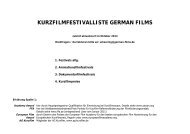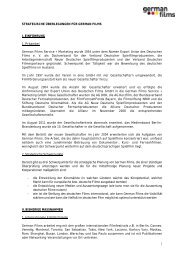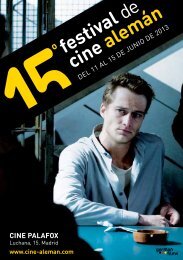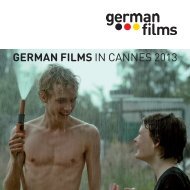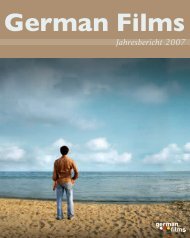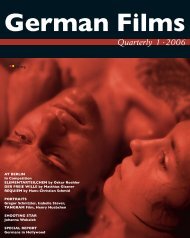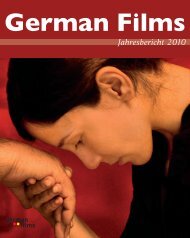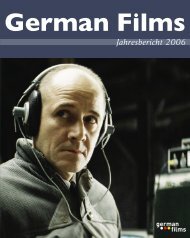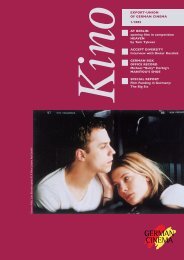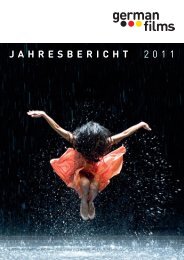Quarterly 4 · 2006 - German Cinema
Quarterly 4 · 2006 - German Cinema
Quarterly 4 · 2006 - German Cinema
You also want an ePaper? Increase the reach of your titles
YUMPU automatically turns print PDFs into web optimized ePapers that Google loves.
In 1985, she was then engaged by Luc Bondy to become a member<br />
of the ensemble at the Schaubuehne am Lehniner Platz in Berlin and<br />
stayed there for twelve years, working with some of the leading directors<br />
such as Peter Stein, Klaus Michael Grueber and Andrea Breth.<br />
She appeared in Stein’s productions of Chekov’s Three Sisters and The<br />
Cherry Orchard, was cast as Madame Lenglumé in Grueber’s staging of<br />
Labiche’s La Affaire Rue de Lourcine and as Charis in Kleist’s<br />
Amphytrion, while the work with Andrea Breth opened up other artistic<br />
horizons with roles in Schnitzler’s Der einsame Weg or Ibsen’s<br />
Hedda Gabler.<br />
Apart from appearing in Gabrielle Baur’s children’s film Die<br />
Bettkoenigin in 1994 and taking a role in a Tatort episode in 1996,<br />
Kogge did not make any forays into film and television during her time<br />
at the Schaubuehne. “I remember people asked me, but it never<br />
worked out time-wise,” she recalls. “My colleague Uli Matthes always<br />
seemed to manage to combine his work for the stage with film roles,<br />
but I didn’t have a name at that time. When I made the film with<br />
Gabrielle, we shot it during the theater holidays.”<br />
Her career opened to work in the other media, though, when she left<br />
the Schaubuehne and engaged an agent to represent her. “It was quite<br />
a change from the stage to being in front of the camera. I was initially<br />
too intense using all of my body and energy,” she observes. “One<br />
works much more independently as an actor on the stage and that’s<br />
something I constantly need to feel although I also like to work in<br />
front of a camera. Film is a bit like a puzzle – you can start at the<br />
beginning or in the middle and slowly the pieces come together –<br />
whereas on the stage you are able to make a creative and formative<br />
contribution over the course of the whole evening. That is the difference.”<br />
While the theater still is very much where she sees her home as an<br />
actress – she has appeared on the stage in Salzburg, Zurich, Berlin,<br />
Stuttgart, Frankfurt and Bochum since leaving the Schaubuehne –<br />
Kogge nevertheless welcomed the chance to take on roles for television<br />
“which allowed me to build up some experience of working<br />
with the camera” with appearances in such popular TV series as Bella<br />
Block or Sperling.<br />
In addition, she has become better known to <strong>German</strong> television<br />
viewers since 2001 thanks to the role of the Brandenburg-based police<br />
detective Johanna Herz in the ARD series Polizeiruf 110. Her performance<br />
in the episode Kleine Frau by Andreas Kleinert brought<br />
her an Adolf Grimme Award this year.<br />
While she has been quite busy working for television, Kogge has only<br />
occasionally been cast for roles in the cinema: she played a waitress<br />
in a champagne bar at Tegel Airport in Andreas Dresen’s Berlinale<br />
competition film Nightshapes, appeared opposite Johanna<br />
Wokalek and Til Schweiger in his romantic comedy Barefoot, and<br />
was the bridegroom’s mother in Dominique Deruddere’s black<br />
comedy The Wedding Party.<br />
She was offered the role of the mother in Hans-Christian Schmid’s<br />
Berlinale <strong>2006</strong> competition film Requiem just two weeks before<br />
shooting was scheduled to begin after Burghart Klaussner (her husband<br />
in the film) recommended her to the director. “It was a very<br />
intensive style of working,” she recalls about the work on Requiem,<br />
“but I like Hans-Christian’s kind of calmness and his preciseness. He<br />
didn’t say very much, but what he said was always spot on. We<br />
rehearsed a lot and then shot very little. Bogumil [Godfredow, the<br />
cinematographer] shot long takes with a hand-held camera and so, in<br />
effect, it was staged as if we were in the theater. The scenes were prepared,<br />
there were rehearsals, one or two takes and that was it. In<br />
spite of the tight shooting schedule he always had that calmness to<br />
explain something or rehearse it once more.”<br />
After the premiere during the Berlinale in February, Kogge was back<br />
in the spotlight in May when she was nominated in the category of<br />
Best Supporting Actress for the <strong>German</strong> Film Awards and was then<br />
awarded one of film’s many prizes at the awards ceremony. “I was<br />
overjoyed and quite surprised that I had won after I saw who else had<br />
been nominated because it was a strong cinema year,” she says, pointing<br />
out that the recognition from her peers in the Deutsche<br />
Filmakademie was “very satisfying”. And as she said in her thank-you<br />
speech after receiving the statuette, “the fact that one should get such<br />
a nice prize for such an austere figure who doesn’t exactly command<br />
one’s sympathy, that is great!”<br />
Imogen Kogge spoke with Martin Blaney<br />
german films quarterly actress’ portrait<br />
4 <strong>·</strong> <strong>2006</strong> 15



